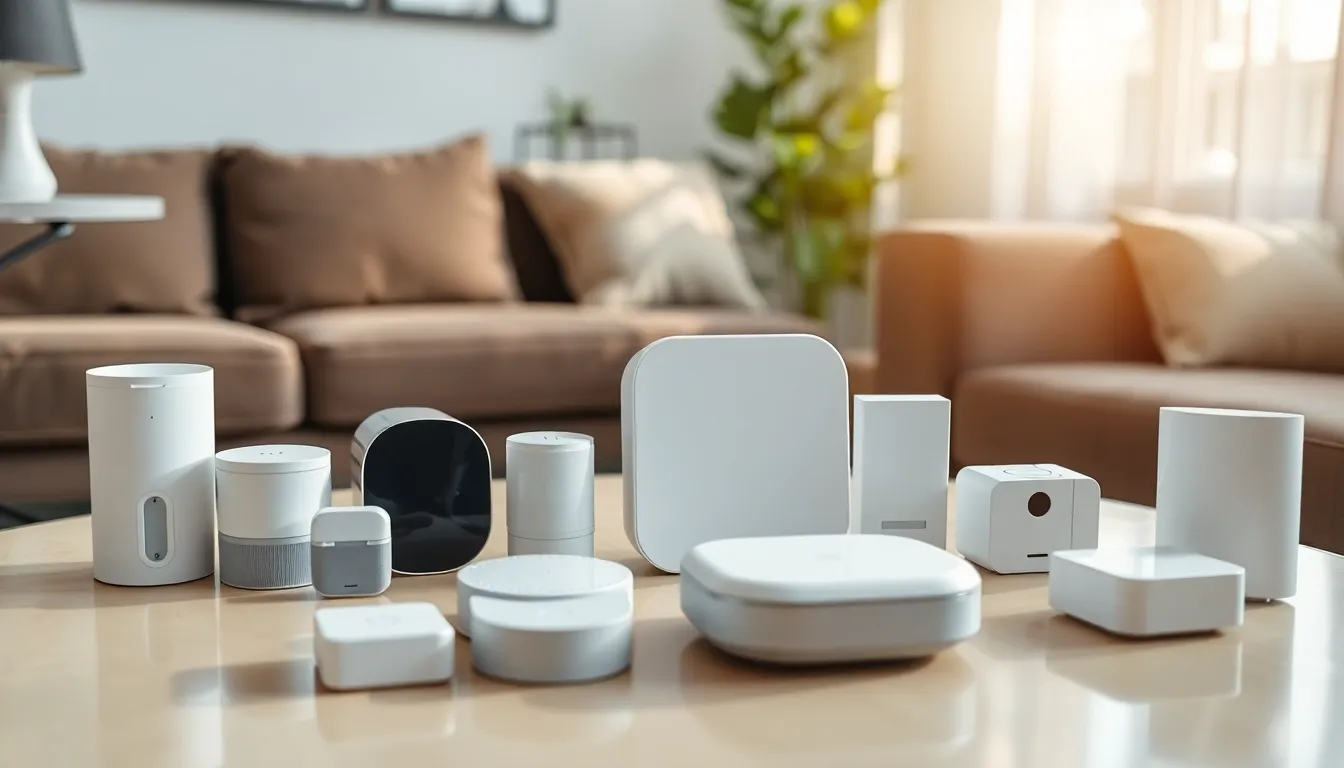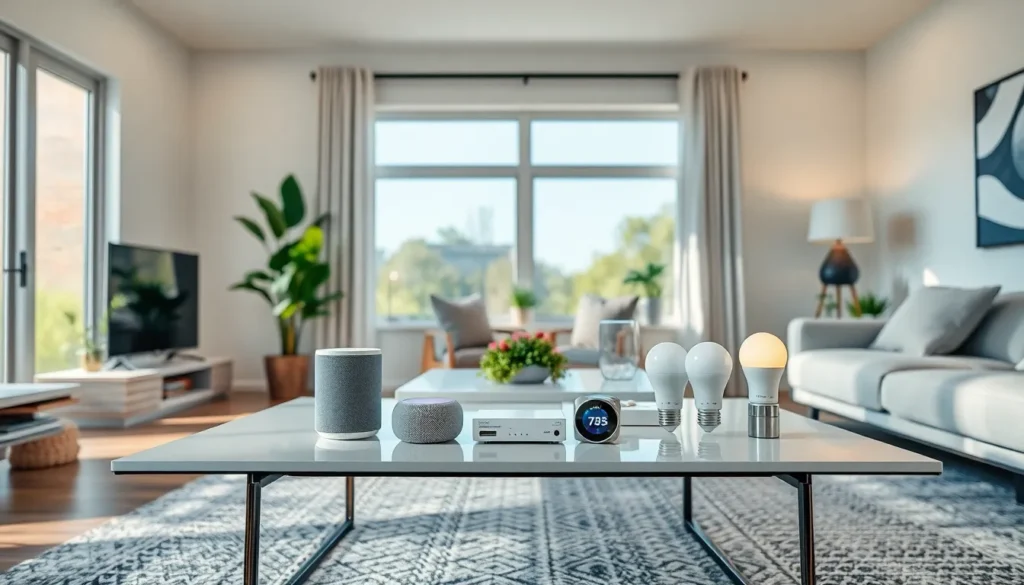Imagine walking into your home and having it greet you like a long-lost friend. Lights flicker on, the thermostat adjusts to your preferred temperature, and your favorite playlist starts playing. Welcome to the world of home automation networking, where convenience meets cutting-edge technology.
As smart devices continue to invade our lives faster than a cat video goes viral, understanding how to network these gadgets becomes crucial. It’s not just about having the latest tech; it’s about creating a seamless, interconnected environment that makes life easier. Dive into the essentials of home automation networking and discover how to turn your humble abode into a smart sanctuary. Who knew that making your home smarter could be this much fun?
Table of Contents
ToggleOverview of Home Automation Networking
Home automation networking integrates smart devices into a cohesive system. This technology allows users to control lighting, security, heating, and more from a central hub. Multiple protocols, such as Wi-Fi, Zigbee, and Z-Wave, facilitate communication among devices. Each protocol offers unique advantages, including range, power consumption, and speed.
Connectivity plays a crucial role in seamless automation. Devices must connect to a network, enabling them to share information and respond to user commands. A well-designed network enhances reliability and ensures that smart devices function optimally.
Smart hubs act as the central control unit for home automation. These hubs collect data from various devices and allow users to manage them through a single interface. Popular hubs include Samsung SmartThings, Amazon Echo Plus, and Google Nest Hub.
Security remains a priority in home automation networking. Properly securing devices prevents unauthorized access and protects personal information. Using strong passwords, enabling two-factor authentication, and regularly updating software can mitigate security risks.
Scalability defines the effectiveness of a home automation system. It’s essential to choose devices and protocols that allow future expansion. Integrating new devices should be straightforward without overhauling the existing system.
Energy efficiency is another benefit of home automation. Smart devices can optimize energy use by adjusting settings based on user habits. For example, smart thermostats learn temperature preferences and adjust accordingly, resulting in reduced energy bills.
Adopting home automation networking enhances the living experience. As technology advances, it provides greater convenience, security, and energy management. Understanding the essentials of connectivity helps homeowners create personalized environments that cater to their needs.
Key Components of Home Automation Networking

Home automation networking comprises essential components that facilitate efficient communication among smart devices. Understanding these components enhances the effectiveness of an automated home environment.
Sensors and Actuators
Sensors play a critical role in monitoring various conditions. They detect changes in light, temperature, movement, and moisture levels. Actuators respond to signals from controllers to perform specific actions, like adjusting blinds or turning lights on and off. Together, these devices create a responsive atmosphere, enhancing user experience and convenience. In smart home systems, advanced sensors include motion detectors, door/window sensors, and environmental sensors. Each sensor type contributes uniquely to the overall functionality, ensuring a seamless automation experience.
Controllers and Hubs
Controllers serve as the brain of the home automation network. They interpret signals from sensors, communicating commands to actuators as needed. Smart hubs consolidate control over multiple devices, simplifying management through a single interface. Popular hubs, such as Samsung SmartThings, Google Nest Hub, and Amazon Echo Plus, provide compatibility with various protocols, allowing diverse devices to connect and communicate effectively. Features like user-friendly apps and voice control enhance usability, making home automation accessible to all homeowners. By streamlining device management, controllers and hubs foster a cohesive home automation experience.
Networking Protocols Used in Home Automation
Understanding networking protocols is vital for achieving effective home automation. These protocols enable communication between smart devices, ensuring a seamless user experience.
Wi-Fi
Wi-Fi serves as one of the most popular connectivity options for home automation. This protocol offers high data transfer speeds, allowing devices to transmit data quickly and efficiently. Many smart devices can connect directly to a home router, simplifying setup and eliminating the need for additional hubs. Compatibility is extensive, as most smartphones and computers support Wi-Fi connections. However, Wi-Fi also tends to consume more power compared to other protocols, which can impact battery-operated devices.
Zigbee
Zigbee operates on a mesh network, facilitating communication among devices without relying heavily on a central hub. This protocol excels in low-power applications, making it ideal for battery-operated devices like sensors and smart switches. Zigbee’s ability to support numerous devices within a single network improves scalability, allowing users to expand their home automation systems easily. Range can be extended as devices relay signals to one another, enhancing overall connectivity. Interference with Wi-Fi signals is minimal, ensuring reliable performance in crowded environments.
Z-Wave
Z-Wave focuses on simplifying home automation with its reliable mesh networking capabilities. This protocol operates on a different frequency than Wi-Fi, reducing the likelihood of interference. Z-Wave’s power consumption is notably low, making it suitable for energy-efficient devices. A single Z-Wave network can support up to 232 devices, offering flexibility for users as they expand their smart home systems. Devices can communicate over greater distances compared to some other protocols, enhancing coverage throughout larger homes.
Benefits of Home Automation Networking
Home automation networking provides several advantages that improve living experiences. Convenience tops the list, allowing users to control various devices from a single interface. Smart hubs eliminate the need for multiple remotes, enabling effortless command of lighting, heating, and security systems.
Energy efficiency significantly enhances household savings. Smart devices monitor usage patterns, making adjustments to reduce energy consumption based on user behavior. Homeowners often experience lower energy bills over time as these systems optimize power use effectively.
Enhanced security also plays a crucial role in home automation networking. Remote monitoring features allow users to keep an eye on their properties through security cameras and alerts, providing peace of mind whether at home or away. Advanced security options include smart locks that can be controlled from smartphones, making it easier to manage access for guests.
Scalability is another important aspect, offering flexibility as lifestyles change. Users can integrate new smart devices effortlessly without overhauling the entire system. This capability ensures that the home remains adaptable to the evolving needs of its inhabitants.
Accessibility is a benefit that improves daily routines, particularly for individuals with disabilities. Voice control features in smart hubs make it easier for everyone to interact with their home systems. It’s possible to adjust the environment using simple commands, enhancing independence and comfort.
Improved communication among devices fosters a seamless experience. Protocols like Zigbee and Z-Wave allow for reliable connections, ensuring devices work harmoniously. As various devices share data effectively, users enjoy a more integrated living space where automation meets convenience.
Challenges in Home Automation Networking
Multiple challenges exist in home automation networking, impacting performance and user experience. Inter-device compatibility often poses significant issues. Many devices utilize different protocols, making it difficult for them to communicate. Ensuring that devices from various manufacturers work seamlessly requires stringent standards.
In addition, network security remains a critical concern. Cyber threats target home networks, potentially compromising personal data. Implementing strong encryption and robust security measures is vital to safeguard against unauthorized access. Regular updates for smart devices help address newly discovered vulnerabilities.
Latency becomes another factor affecting home automation. High response times can frustrate users, particularly when instant actions are expected. Frequent network congestion, especially with multiple devices online, may lead to delays in commands. Optimizing network infrastructure alleviates some of these issues.
Scalability presents its own set of challenges as well. Adding new devices shouldn’t require replacing existing equipment. However, some systems struggle to integrate additional components efficiently, resulting in compatibility problems. Users prefer solutions that accommodate future expansions without excessive complexity.
Finally, user interface design plays a significant role in overall satisfaction. If controls are complicated or unintuitive, users may not utilize the full potential of their smart devices. Simplifying interactions and providing clear instructions enhance the user experience. Focusing on these key challenges can drive improvements in home automation networking.
Home automation networking represents a significant leap toward creating smarter living spaces. By understanding the intricacies of device connectivity and the various protocols available, homeowners can tailor their environments to suit their unique lifestyles. The seamless integration of smart devices not only enhances convenience and security but also promotes energy efficiency and scalability.
As technology continues to evolve, embracing home automation can lead to a more personalized and responsive living experience. With the right tools and practices in place, individuals can transform their homes into efficient havens that meet their needs while ensuring peace of mind. The journey into home automation is just beginning, and the possibilities are endless.




